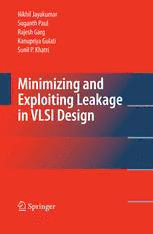Table Of ContentMinimizing and Exploiting Leakage in VLSI Design
Nikhil Jayakumar Suganth Paul
(cid:129)
Rajesh Garg Kanupriya Gulati
(cid:129)
Sunil P. Khatri
Minimizing and Exploiting
Leakage in VLSI Design
123
NikhilJayakumar Dr.KanupriyaGulati
MorseAvenue1168 311StasneySt.
94089,Sunnyvale CollegeStationTX77840
USA Apt.1205
[email protected] USA
[email protected]
Dr.SuganthPaul
5701S.MopacExpressway Dr.SunilP.Khatri
AustinTX78479 TexasA&MUniversity
#1523 Dept.Electrical&ComputerEngineering
USA CollegeStationTX
[email protected] 77843-3128
214ZachryEngineeringCenter
Dr.RajeshGarg USA
6430NEAlderSt. [email protected]
HillsboroOR97124
Apt.B
USA
[email protected]
ISBN978-1-4419-0949-7 e-ISBN978-1-4419-0950-3
DOI10.1007/978-1-4419-0950-3
SpringerNewYorkDordrechtHeidelbergLondon
LibraryofCongressControlNumber:2009939713
(cid:2)c SpringerScience+BusinessMedia,LLC2010
Allrightsreserved.Thisworkmaynotbetranslatedorcopiedinwholeorinpartwithoutthewritten
permission of the publisher (Springer Science+Business Media, LLC, 233 Spring Street, New York,
NY10013, USA),except forbrief excerpts inconnection with reviews orscholarly analysis. Usein
connectionwithanyformofinformationstorageandretrieval,electronicadaptation,computersoftware,
orbysimilarordissimilarmethodologynowknownorhereafterdevelopedisforbidden.
Theuseinthispublicationoftradenames,trademarks,servicemarks,andsimilarterms,eveniftheyare
notidentifiedassuch,isnottobetakenasanexpressionofopinionastowhetherornottheyaresubject
toproprietaryrights.
Printedonacid-freepaper
SpringerispartofSpringerScience+BusinessMedia(www.springer.com)
To ourparentsand ourteachers
Foreword
PowerconsumptionofVeryLargeScaleIntegrated(VLSI)circuitshasbeengrow-
ingatanalarminglyrapidrate.Thisincreaseinpowerconsumption,coupledwith
the increasing demand for portable/hand-held electronics, has made power con-
sumption a dominant concern in the design of VLSI circuits today. Traditionally
dynamic (switching) power has dominated the total power consumption of VLSI
circuits. However, due to process scaling trends, leakage power has now become
a major component of the total power consumption in VLSI circuits. This book
presentstechniquestoreduceleakage,aswellastechniquestoexploitleakagecur-
rentsthroughtheuseofsub-thresholdcircuits.
Thisbookconsistsofthreeparts.Inthe firstpart,techniquesto reduceleakage
arepresented.Theseincludeanalgebraicdecisiondiagram(ADD)basedapproach
to implicitly represent the leakage correspondingto all possible inputs to a com-
binationaldesign,a heuristictechniqueto find the minimumleakagevectorin the
presenceofrandomProcess,VoltageandTemperature(PVT)variationsusingsig-
nalprobabilities,alow-leakageASICdesignmethodologythatuseshigh-V sleep
T
transistors selectively, a methodology that combines input vector control and cir-
cuit modification, and a scheme to find the optimum reverse body bias voltage to
minimizeleakage.
AstheminimumfeaturesizeofVLSIfabricationprocessescontinuestoshrink
witheachsuccessiveprocessgeneration(alongwiththevalueofsupplyvoltageand
thereforethethresholdvoltageofthedevices),leakagecurrentsincreaseexponen-
tially.LeakagecurrentsarehenceseenasanecessaryevilintraditionalVLSIdesign
methodologies.Wepresentanapproachtoturnthisproblemintoanopportunity.In
thesecondpartofthisbook,weattempttoexploitleakagecurrentstoperformcom-
putation.Weusesub-thresholddigitalcircuitsandcomeupwithwaystogetaround
some of the pitfalls associated with sub-threshold circuit design. These include a
techniquethatusesbodybiasingadaptivelytocompensateforPVTvariations,ade-
sign approachthat uses asynchronousmicro-pipelinedNetwork of Programmable
Logic Arrays (NPLAs) to help improve the throughput of sub-threshold designs,
andamethodtofindtheoptimumsupplyvoltagethatminimizesenergyconsump-
tioninacircuit.
While the second part of the book goes into details of various sub-threshold
design approaches, the third part of this book presents silicon validation of these
vii
viii Foreword
approaches.Thethirdpartofthisbookpresentsdesignandimplementationdetails
ofasub-thresholdwirelessBFSKtransmitterchip.Thischipwasdesignedandfab-
ricated to prove the feasibility of the sub-threshold design approaches detailed in
the second part of this book.We also presentresults from tests carried out on the
fabricateddiethatprovethevalueofsub-thresholddesign.
Thisbookwillserveasavaluablereferencetoanyoneinterestedinunderstanding
leakagecurrentsin moderndayDSM processesandto thoseinterested notjustin
leakage reduction but also in how to exploit it to make practical ultra-low power
integratedcircuits.
Sunnyvale,CA NikhilJayakumar
Austin,TX SuganthPaul
Portland,OR RajeshGarg
CollegeStation,TX KanupriyaGulati
CollegeStation,TX SunilP.Khatri
Preface
Powerconsumptionisamajorconcernintoday’sVLSIdesigns.Inparticular,leak-
agepowerhasbecomeasignificantcomponentofthetotalpowerconsumptionofa
chipandhasthusreceivedmuchattentioninrecentDeepSub-micron(DSM)pro-
cesses.
Thisbookconsistsofthreeparts.Thefirstpartofthisbookaddressesleakagere-
ductionapproacheswhilethesecondexplorestechniquestoexploitleakagecurrents
toperformcomputation.Inthethirdpartofthebook,wepresentatestapplication
ofthetechniquespresentedinthesecondpart.
SinceleakagepowerconsumptionisseenasamajorissueinVLSIdesigntoday,
there has been significant research into techniques to reduce leakage. In Part I of
this book,new techniquesto reduceleakage are proposed.These includean alge-
braic decision diagram (ADD) based approachto implicitly representthe leakage
correspondingtoallpossibleinputstoacombinationaldesign,aheuristictechnique
tofindtheminimumleakagevectorinthepresenceofrandomProcess,Voltageand
Temperature(PVT)variationsusingsignalprobabilities,adesignapproachthatuses
high-V sleep transistors selectively, a technique that modifies a circuit to reduce
T
leakagewhilesimultaneouslyfindingthebestinputvectorthatminimizesleakage
andaschemetofindtheoptimumreversebodybiasingvoltagetominimizeleakage.
Inthesecondpartofthisbook,weattempttoexploitleakagecurrentsratherthan
minimize them. We propose the use of sub-threshold digital circuits and present
waystogetaroundsomeofthepitfallsassociatedwithsub-thresholdcircuitdesign.
These include a self-adjusting adaptive body-biasingtechnique that helps make a
sub-thresholdcircuitlesssensitivetoPVTvariations,adesignapproachthathelps
improvethe throughputof sub-thresholddesignsthroughthe use of asynchronous
micro-pipelinedNetworkof ProgrammableLogicArrays(NPLAs), and a method
tofindtheoptimumsupplyvoltagethatminimizesenergyconsumptioninacircuit.
Inthethirdpartofthisbook,wegooverdesigndetailsofasub-thresholdwireless
BFSKtransmitterIC.Datagatheredfromexperimentscarriedoutonthefabricated
die arealso presentedalongwitha comparisonto regularstandard-cell-basedver-
sionoftheBFSKcircuit.
ix
x Preface
BookOutline
Thisbookisorganizedintothreeparts.
PartI of the bookfocusesonminimizingleakage.In Chap. 2, we surveysome
existing approaches to leakage reduction. This chapter is a good starting point to
anyone interested in knowing the basic set of tricks used by digital designers to-
day to tackle the problemof leakage currents.ADD-based exactand approximate
techniquestoimplicitlycomputetheleakageofacombinationaldesignforallpos-
sible inputsarepresentedin Chap.3.Chapter4describesa heuristicapproachfor
computing the minimum leakage vector for a combinational circuit using signal
probabilities.Thisapproachisfurtherextendedto accountforrandomPVT varia-
tions. In Chap. 5, we presenta new low-leakagestandard cell-based ASIC design
methodology,calledthe“HL”methodologythatachievesleakagereductionthrough
selective use of low-leakage variants of a standard cell. In Chap. 6, another de-
signapproachispresentedthatreducesleakagethroughusingdifferentvariantsof
astandardcelland“parking”thecircuitinitslowestleakagestate.InChap.7some
experimentalresults are presentedto provethat there is an optimumreverse body
biasvoltageforleakageminimizationandthendetailsofacircuitthatcanfindthis
optimumreversebodybiasvoltagearepresented.
InPartIIofthisbook,welookatleakagecurrentsdifferentlyandpresentprac-
tical techniques and methodologies that exploit leakage to perform computation.
In Chap. 9, the reader is introduced to the idea of operating circuits in the sub-
threshold region and thus exploiting leakage. This is a useful chapter to anyone
interested in understanding the basics of sub-threshold circuit design and opera-
tion.InChap.10,wepresentasub-thresholddesignmethodologythatcompensates
for the high sensitivity of sub-threshold circuits to Process, Voltage and Temper-
ature (PVT) variations. This is a recommended chapter for readers who design
or are planning to design ultra-low power (low voltage) circuits apart from sub-
thresholdcircuits;themethodologypresentedinthischaptercanalsobeappliedfor
circuitsoperatingatextremelylowvoltagesnearthesub-thresholdregionofoper-
ation.In Chap.11, we discusshow the optimumvoltagefor low energycan often
bemuchhigherthantheoptimumvoltageforpower.InChap.12,anasynchronous
micropipelineddesignflow andmethodologyis presentedto alleviatesome ofthe
speedconcernsofsub-thresholdcircuits.
InPartIIIofthisbook,wepresentdetailsofhowweimplementedasub-threshold
BFSKtransmitterICthatutilizessomeofthesub-thresholddesigntechniquespre-
sented in Part II of this book. It is recommended that the reader read this part of
thebookonlyafterreadingPartIIofthisbook(specificallyChap.10).InChap.14,
Preface xi
thearchitectureofthetransmitterisexplainedindetail.Chapter15delvesintothe
implementationdetailsoftheIC.Someresultsfromtheexperimentsperformedon
thefabricateddiearepresentedinChap.16.
Sunnyvale,CA NikhilJayakumar
Austin,TX SuganthPaul
Portland,OR RajeshGarg
CollegeStation,TX KanupriyaGulati
CollegeStation,TX SunilP.Khatri
Acknowledgments
This book contains the results of several years of research by its authors, starting
in2003.Theworkpresentedinthisbookhasbeenpossible–thankstothesupport
frommanysources.
The contents of this book are the result of research first started by two of the
authors(Dr.NikhilJayakumarandDr.SunilP.Khatri)attheUniversityofColorado
atBoulder.We wouldlike tothankthestudentsandfacultyatBoulder,whereour
research on leakage power was initiated. We also wish to thank the students and
faculty at Texas A&M University, where we continued our research into leakage
andpublishedseveralmorepapersinthearea.
The work presented in this book would not have been possible without the
tremendousamount of help and encouragementwe have received from our fami-
lies,friends,andcolleagues.
Firstwewouldliketogratefullyacknowledgethefundingsupportwithoutwhich
thesubthresholdtransmitterICwouldnothavebeenpossible.Thisincludessupport
from Lawrence Livermore National Laboratories (LLNL) and the National Cen-
ter for MASINT Research (NCMR). The support of Drs. Sheila Vaidya and Pete
Bythrowisespeciallyappreciated.
The work presented in this book would not have been possible without the
tremendousamount of help and encouragementwe have received from our fami-
lies,friends,andcolleagues.
xiii

